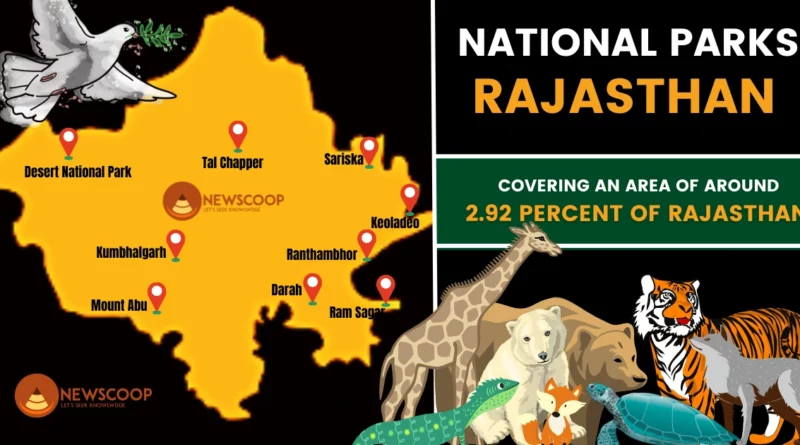National Parks of Rajasthan: Map & Features
Rajasthan, a land of vibrant culture and regal history, is not just limited to magnificent palaces and desert landscapes. Nestled within its vast expanse are several national parks, each with its own unique charm and ecological diversity.
From endangered wildlife species to breathtaking landscapes, Rajasthan’s national parks offer a splendid opportunity for nature enthusiasts and wildlife lovers to immerse themselves in the lap of natural beauty. In this article, we invite you to embark on a virtual journey through the mesmerizing national parks of Rajasthan.
Rajasthan
Rajasthan, the largest state in India, is situated in the northwestern region of the country and covers an expansive area of 342,239 square kilometers, accounting for 10.40 percent of the country’s total geographical area.
With a strong commitment to conservation, Rajasthan boasts a well-established Protected Area network comprising 5 National Parks, 25 Wildlife Sanctuaries, and 11 Conservation Reserves, collectively covering 2.92 percent of the state’s land.
Among these protected areas, three have been designated as Project Tiger sites, namely Ranthambhore, Sariska, and Mukundra Hills, highlighting the state’s dedication to preserving its rich biodiversity.
Additionally, Rajasthan is home to two Ramsar sites, the Keoladeo Ghana Sanctuary, and Sambhar Lake, recognized for their international significance in terms of wetland conservation.
The state can be divided into four distinct regions, each with its own unique geographical features:
- Western Desert with Barren Hills
- Level Rocky and Sandy Plains
- Aravalli Hills
- South-Eastern Plateau
National Parks of Rajasthan
There are five national parks in Rajasthan:
- Desert National Park
- Ranthambore National Park
- Sariska National Park
- Mukundara Hills National Park (Darrah National Park)
- Keoladeo National Park
| National Park | Area (in square kilometers) |
|---|---|
| Desert National Park | 3,162 sq. km |
| Ranthambore National Park | 274 sq. km |
| Sariska National Park | 273 sq. km |
| Mukundara Hills National Park | 200 sq. km |
| Keoladeo National Park | 29 sq. km |
National Parks of Rajasthan on Map
The following map shows the National Parks of Rajasthan:

1. Ranthambore National Park
- Location: Sawai Madhopur district in southeastern Rajasthan.
- Unique Flora: The park features a dry deciduous forest with over 300 species of plants, including Dhok trees, banyan trees, mango trees, and pipal trees.
- Unique Fauna: Renowned for its Bengal tigers, Ranthambore is one of the best places in India to spot these majestic animals. Other wildlife found here includes Indian leopards, sloth bears, Indian wild boars, chital, sambar deer, and various bird species.
2. Sariska National Park
- Location: Alwar district in northeastern Rajasthan.
- Unique Flora: The park comprises a mixed forest of deciduous trees, including Dhok trees, khair trees, and ber trees.
- Unique Fauna: Sariska is known for its population of Bengal tigers, which were reintroduced in 2008. Other wildlife species found here include Indian leopards, Indian striped hyenas, Indian jackals, chital, sambar deer, and various bird species.
3. Keoladeo National Park
- Location: Bharatpur district in eastern Rajasthan.
- Unique Flora: The park is characterized by a wetland ecosystem, consisting of shallow lakes, marshes, and swamps. It is home to over 350 species of plants, including various water lilies, lotuses, and reeds.
- Unique Fauna: Keoladeo is famous for its migratory birds, with over 375 species recorded here. During winter, the park becomes a haven for Siberian cranes, pelicans, storks, ducks, geese, and other bird species.
4. Desert National Park
- Location: Jaisalmer district in western Rajasthan.
- Unique Flora: The park showcases a distinct ecosystem of sand dunes, rocky outcrops, and scrub forests. It is home to several desert plants such as Khejri trees, acacia trees, and cacti.
- Unique Fauna: Notable wildlife species in the park include the critically endangered Great Indian Bustard. Other desert animals found here are desert foxes, Indian gazelles, and sand boas.
5. Mukundra Hills National Park
- Location: Kota district in southeastern Rajasthan.
- Unique Flora: The park features a mixed forest of deciduous trees, including Dhok trees, khair trees, and ber trees.
- Unique Fauna: Mukundra Hills is known for its population of big cats, including Bengal tigers and leopards. The park also hosts Indian wild dogs, Indian foxes, sloth bears, and various bird species.
Here’s a table summarizing the National Parks in Rajasthan with their location, unique flora, and unique fauna:
| S. No. | National Park | Location | Unique Flora | Unique Fauna |
|---|---|---|---|---|
| 1 | Ranthambore National Park | Sawai Madhopur district, southeastern Rajasthan | Dhok trees, banyan trees, mango trees, pipal trees | Bengal tigers, Indian leopards, sloth bears, Indian wild boars, chital, sambar deer, various bird species |
| 2 | Sariska National Park | Alwar district, northeastern Rajasthan | Dhok trees, khair trees, ber trees | Bengal tigers, Indian leopards, Indian striped hyenas, Indian jackals, chital, sambar deer, various bird species |
| 3 | Keoladeo National Park | Bharatpur district, eastern Rajasthan | Water lilies, lotuses, reeds | Migratory birds (Siberian cranes, pelicans, storks, ducks, geese), various bird species |
| 4 | Desert National Park | Jaisalmer district, Western Rajasthan | Khejri trees, acacia trees, cacti | Great Indian Bustard, desert foxes, Indian gazelles, sand boas |
| 5 | Mukundra Hills National, Park (Darrah National Park) | Kota district, southeastern Rajasthan | Dhok trees, khair trees, ber trees | Bengal tigers, leopards, Indian wild dogs, Indian foxes, sloth bears, various bird species |
Conclusion
In conclusion, the National Parks of Rajasthan showcase the state’s diverse flora and fauna, including iconic species like Bengal tigers and Great Indian Bustards. These parks play a vital role in wildlife conservation and provide a unique opportunity to explore Rajasthan’s natural beauty and ecological balance.
Additionally, they attract migratory birds and offer visitors a chance to connect with nature and appreciate the stunning landscapes of the region.
Thank You!

